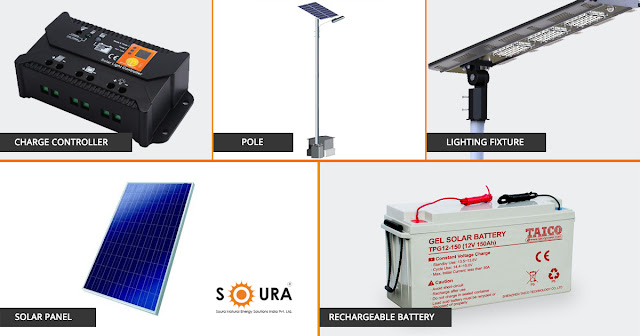Solar street lights are raised light sources which are powered by photovoltaic panels generally mounted on the lighting structure or integrated into the pole itself. The photovoltaic panels charge a rechargeable battery, which powers a fluorescent or LED lamp during the night.
Components of Solar Street Lights:
Solar Panel
It is very important part of solar street lights. Their main work is to convert solar energy into electricity. There are 2 types of solar panel exists - Mono-crystalline and polycrystalline. The Conversion rate of the mono-crystalline solar panel is much higher than polycrystalline.
Lighting Fixture
The latest solar street light used LED as lighting source because it provides much higher Lumens with lower consumption of power. The energy consumption rate of a LED fixture is at least 50% lower than HPS fixture.
Rechargeable Battery
The Rechargeable Battery stores the electricity from the solar panel during the day and provides power to the fixture during the night.
There are generally 2 types of batteries used:
a) Gel Cell Deep Cycle Battery
b) Lead Acid Battery
Controller
The controller is also a very important part of the solar street light. A controller is that circuit which decides when to switch on /off charging and lighting.
Pole
Strong Poles are required to solar street lights because there are very heavy components are mounted on the top of the pole like Fixtures, Panels and sometimes batteries.
Working of Solar Street Lights:
The solar street lights use solar energy, a form of the renewable energy. These days it is common to see the solar street lamps along the sides of roads. The solar street lights comprise of the photovoltaic cells, which absorb the solar energy during the daytime. The photovoltaic cells convert solar energy into electrical energy, which is stored in the battery. At the nighttime, the lamp starts automatically and it consumes the electricity already stored in the battery. During the daytime, the battery gets recharged and the process keeps on repeating every day.
Advantages:
• Solar street lights are independent of the utility grid. Hence, the operation costs are minimized.
• Solar street lights require much less maintenance compared to conventional street lights.
• Since external wires are eliminated, the risk of accidents is minimized.
• This is a non-polluting source of electricity
• Separate parts of a solar system can be easily carried to the remote areas
• It allows the saving of energy and also cost.
For more information: Soura Natural Energy Solutions



i really appreciate your blog. it is very interesting and informative.
ReplyDeleteSolar Panel Home Cost
Solar Installers Near Me